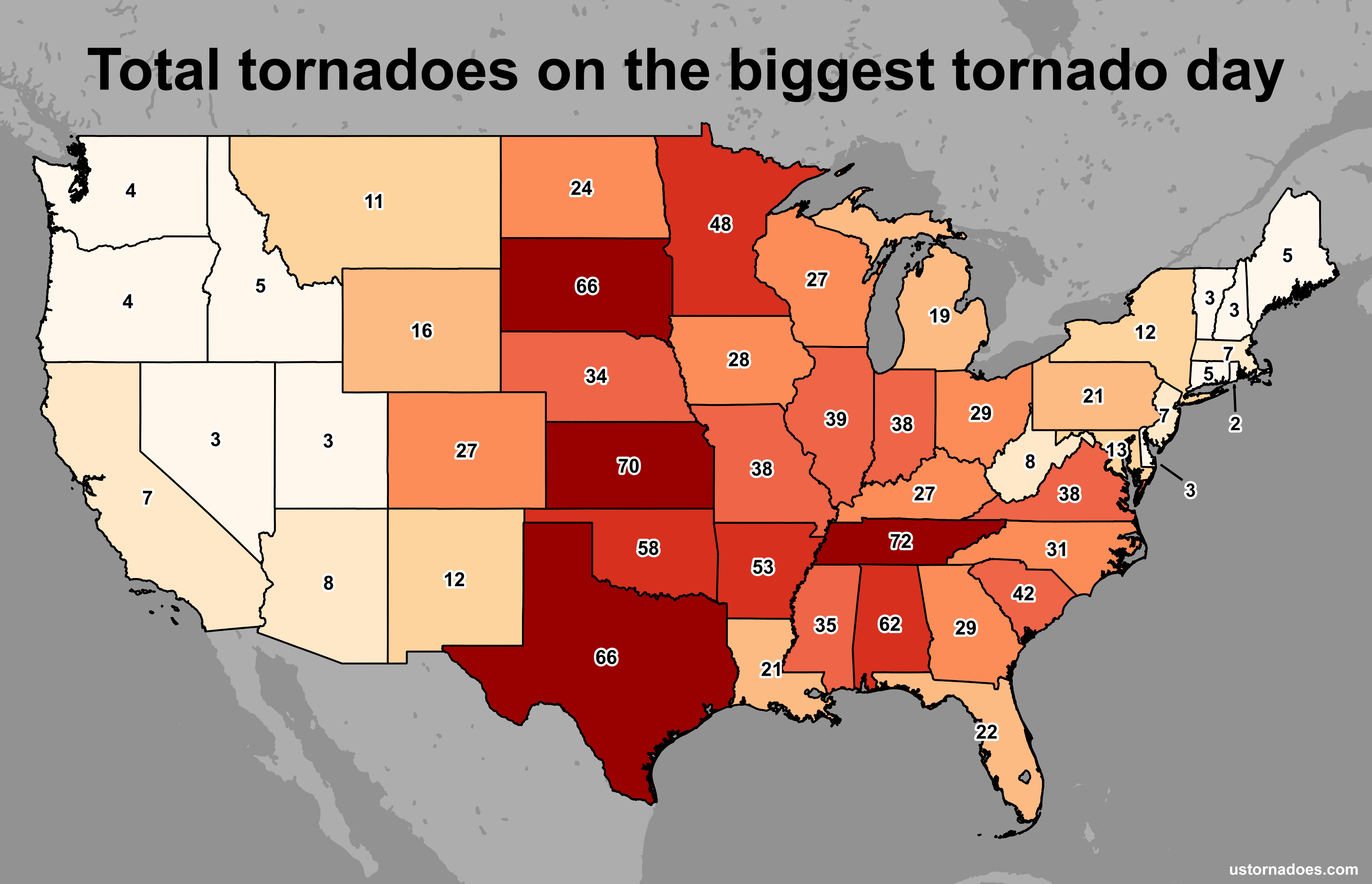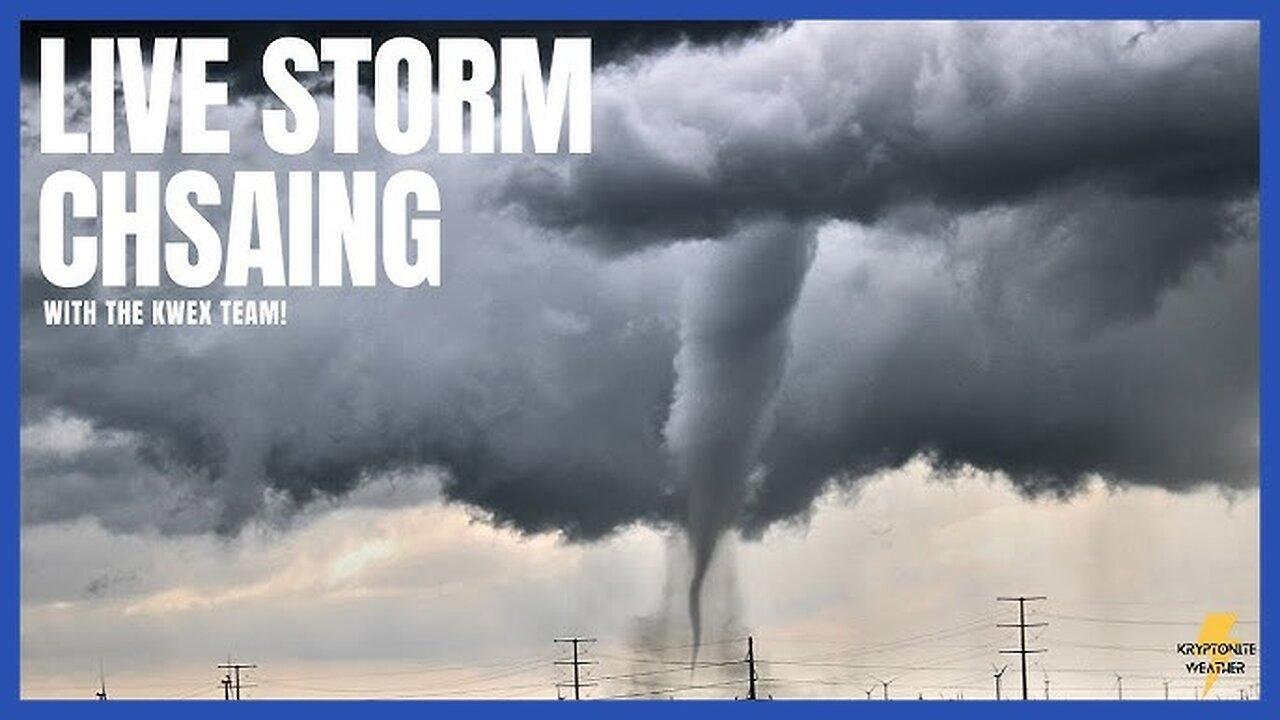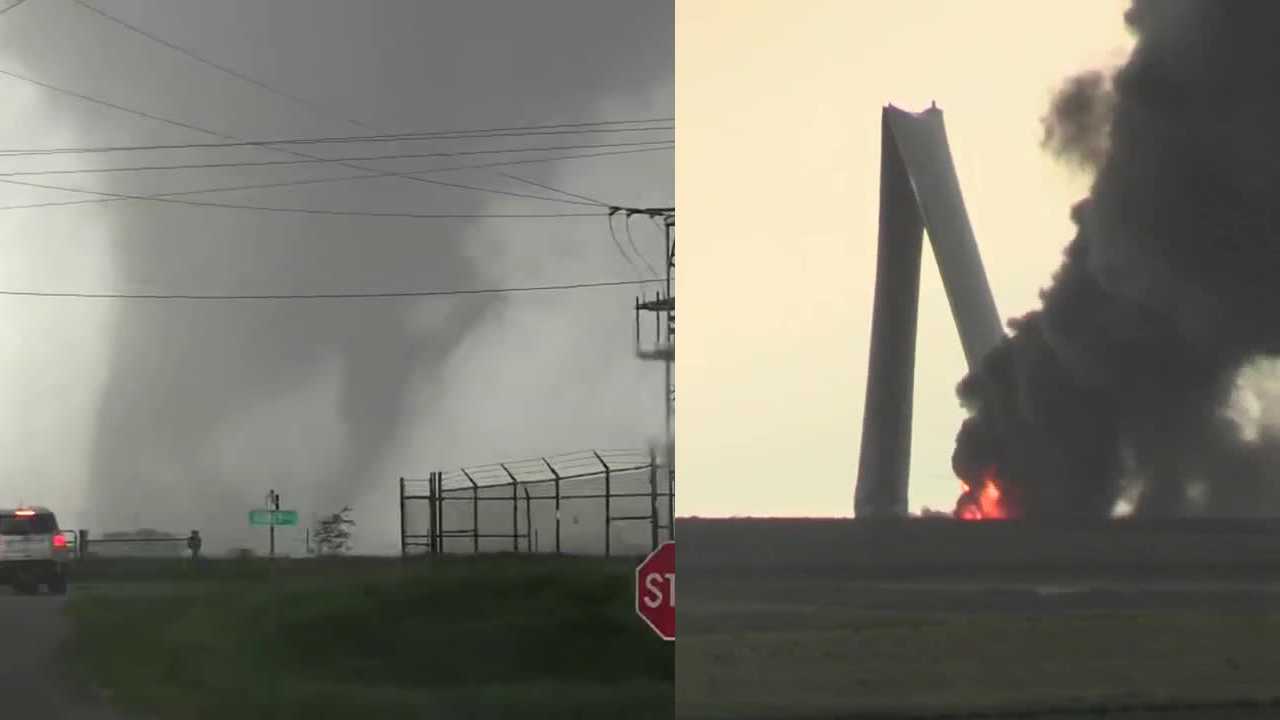Iowa Tornado History: Tornado In Iowa
Tornado in iowa – Iowa, located in the heart of Tornado Alley, has a long and devastating history with tornadoes. The state experiences an average of 53 tornadoes annually, more than any other state in the nation. These tornadoes range in intensity from weak EF0s to violent EF5s, leaving a trail of destruction and heartbreak in their wake.
The earliest recorded tornado in Iowa occurred in 1844, and since then, the state has been hit by numerous significant tornado outbreaks. One of the most notable was the 1974 Super Outbreak, which produced a record-breaking 148 tornadoes across the Midwest, including several that touched down in Iowa. The outbreak caused widespread damage and claimed the lives of six people in the state.
Notable Tornado Events
- 1878 Grinnell Tornado: An EF4 tornado struck the town of Grinnell, killing 19 people and injuring over 100.
- 1965 Parkersburg Tornado: An EF5 tornado devastated the town of Parkersburg, killing nine people and destroying over 200 homes.
- 2008 Parkersburg Tornado: Another EF5 tornado hit Parkersburg, causing extensive damage and killing six people.
- 2013 Moore Tornado: An EF5 tornado struck the town of Moore, Oklahoma, just across the border from Iowa. The tornado caused widespread destruction and killed 24 people.
Tornado Climatology

Iowa’s tornado climatology is characterized by frequent and occasionally severe tornado events. Understanding the climatological factors that contribute to tornado formation, their seasonal patterns, geographical distribution, and the influence of weather systems and atmospheric conditions is crucial for effective tornado preparedness and mitigation.
In Iowa, tornadoes are a destructive force of nature that can cause widespread damage. The state has been hit by numerous tornadoes over the years, including the deadly EF5 tornado that struck Parkersburg in 2008. For more information on tornadoes in Iowa, including safety tips and resources, visit tornado iowa .
Seasonal Patterns
Iowa’s tornado season typically spans from April to June, with May being the peak month for tornado activity. However, tornadoes can occur outside this period, particularly during the fall months. The state experiences an average of 50 to 60 tornadoes annually, with significant year-to-year variability.
Geographical Distribution
Tornadoes can occur anywhere in Iowa, but the highest frequency of tornadoes is observed in the central and western portions of the state. This region, known as Tornado Alley, is characterized by favorable atmospheric conditions and frequent severe thunderstorms.
The tornado in Iowa left a trail of destruction, with Greenfield being one of the hardest-hit areas. The tornado’s fury tore through the town, leaving behind damaged homes, businesses, and infrastructure. The aftermath of the tornado in Iowa is a reminder of the devastating power of nature.
Weather Systems and Atmospheric Conditions, Tornado in iowa
The formation of tornadoes in Iowa is influenced by a combination of weather systems and atmospheric conditions. These include:
- Supercell thunderstorms: These storms have rotating updrafts that can produce tornadoes.
- Dryline: A boundary between moist and dry air that can enhance thunderstorm development.
- Jet stream: A high-altitude wind current that can provide the necessary wind shear for tornado formation.
- Instability: A measure of the atmosphere’s potential for vertical movement, which is essential for thunderstorm development.
- Wind shear: A change in wind speed and direction with height, which helps organize thunderstorms and promotes tornado formation.
Tornado Safety and Preparedness
When severe weather strikes, it’s crucial to prioritize your safety. Tornadoes, with their immense power and unpredictable nature, demand a well-rounded approach to preparedness and safety measures. Understanding the warning systems, developing emergency plans, and knowing how to seek shelter can significantly increase your chances of staying safe during these dangerous events.
Tornadoes in Iowa are a serious threat, with the state experiencing an average of 50 tornadoes per year. Iowa’s tornadoes can be particularly destructive, as they often occur in populated areas and can cause widespread damage. For more information on Iowa’s tornadoes, visit iowa tornados . This website provides detailed information on the history, climatology, and impacts of tornadoes in Iowa.
Tornado Warning Systems
Timely and accurate warnings are vital for tornado safety. The National Weather Service (NWS) issues tornado warnings based on radar data and reports from trained spotters. These warnings are disseminated through various channels, including:
- Weather radios: NOAA Weather Radios are specialized receivers that broadcast continuous weather information, including tornado warnings. They are an essential tool for staying informed, especially in areas with limited cell phone coverage.
- Cell phone alerts: Most smartphones can receive Wireless Emergency Alerts (WEAs), which include tornado warnings. Ensure your phone is configured to receive these alerts.
- Local media: Television and radio stations broadcast tornado warnings as part of their regular programming. Pay attention to these broadcasts and follow the instructions provided.
Tornado Damage Assessment

Evaluating the severity and extent of damage inflicted by tornadoes is crucial for recovery and rebuilding efforts. Damage assessment involves meticulous documentation and analysis to determine the nature and magnitude of destruction caused by these violent storms.
Tornadoes are a common occurrence in Iowa, with an average of 50 tornadoes reported each year. For the latest information on tornadoes in Iowa, visit iowa tornado today . The site provides real-time updates on tornado warnings and watches, as well as safety tips and resources.
Tornadoes can be dangerous, so it is important to be aware of the risks and to take precautions when necessary.
Assessing tornado damage entails a comprehensive approach that encompasses various methods and techniques. These include field surveys, aerial reconnaissance, remote sensing, and detailed structural inspections. Each method provides valuable insights into the extent and severity of the damage, allowing experts to classify and quantify the impacts.
Tornadoes in Iowa can be devastating, and the Greenfield tornado of 2004 was no exception. With winds reaching up to 160 miles per hour, it tore through the town, leaving a path of destruction in its wake. But even in the face of such devastation, the people of Iowa came together to rebuild their community.
And today, Greenfield stands as a testament to the resilience of the human spirit.
Types of Tornado Damage
Tornadoes can inflict a wide range of damage, affecting both the built environment and natural ecosystems. The types of damage can be broadly categorized as:
- Structural Damage: Tornadoes can cause catastrophic damage to buildings, homes, infrastructure, and other structures. The force of the winds can rip roofs off, collapse walls, shatter windows, and even lift entire structures off their foundations.
- Property Loss: Tornadoes can result in significant property loss, including damage to vehicles, personal belongings, livestock, and agricultural crops. The debris and wreckage left behind can pose hazards and hinder recovery efforts.
- Environmental Impacts: Tornadoes can also have severe environmental consequences. They can uproot trees, strip vegetation, and alter landscapes. The destruction of natural habitats can disrupt ecosystems and impact wildlife populations.
Damage Assessment Techniques
Various techniques are employed to assess tornado damage, including:
- Field Surveys: Teams of experts conduct on-site inspections to document and evaluate the damage. They assess structural integrity, property loss, and environmental impacts.
- Aerial Reconnaissance: Aerial surveys using aircraft or drones provide a broader perspective of the damage path. They can quickly identify areas of severe destruction and facilitate the deployment of resources.
- Remote Sensing: Satellite imagery and radar data can be used to analyze tornado tracks and assess the extent of damage over large areas. These technologies can identify patterns and provide valuable information for damage mapping.
- Structural Inspections: Detailed inspections of damaged buildings are conducted to determine the extent of structural damage. Engineers assess the integrity of walls, roofs, and foundations to determine if structures are safe for re-entry or require repairs.
Tornado Research and Mitigation
In the relentless pursuit of understanding and mitigating the destructive force of tornadoes, scientists and engineers engage in ongoing research and development. Technological advancements and innovative strategies play a pivotal role in predicting, warning, and reducing the impact of these formidable weather phenomena.
Understanding the intricacies of tornado formation and behavior requires meticulous observation and analysis. Doppler radar systems, deployed across vast networks, provide real-time data on wind speeds and patterns, enabling meteorologists to track and forecast tornadoes with greater accuracy. Numerical weather prediction models, powered by supercomputers, simulate atmospheric conditions to predict the likelihood and trajectory of tornadoes, providing valuable lead time for issuing warnings.
Tornado Forecasting and Warning Systems
The rapid dissemination of tornado warnings is crucial for public safety. Advanced warning systems, such as the National Weather Service’s Tornado Warning System, utilize a combination of radar data, spotter reports, and automated algorithms to issue timely and precise warnings. These warnings are transmitted through multiple channels, including sirens, mobile phone alerts, and social media, ensuring widespread awareness and enabling individuals to take appropriate shelter.
Mitigation Strategies
Beyond forecasting and warning, innovative mitigation strategies aim to reduce the vulnerability of communities to tornadoes. Building codes and construction practices have evolved to incorporate tornado-resistant designs, utilizing reinforced concrete structures and wind-resistant materials. Tornado shelters, specifically designed to withstand the immense forces of a tornado, provide safe havens for individuals and families in affected areas.
Land-use planning also plays a role in tornado mitigation. By regulating development in high-risk areas and promoting vegetation management, communities can reduce the potential for tornado damage and enhance overall resilience.
Economic and Social Impacts of Tornadoes

Tornadoes have significant economic and social impacts on communities in Iowa. The economic costs associated with tornadoes include property damage, business disruption, and agricultural losses. Tornadoes can damage or destroy homes, businesses, schools, and other buildings. They can also damage or destroy crops, livestock, and farm equipment. The economic impact of a tornado can be devastating, especially in rural areas where agriculture is the primary industry.
In addition to the economic costs, tornadoes can also have a significant social and psychological impact on communities. Tornadoes can cause injuries and death, and they can also displace people from their homes. The experience of a tornado can be traumatic, and it can lead to anxiety, depression, and other mental health problems. Tornadoes can also damage or destroy community infrastructure, such as schools, hospitals, and roads. This can make it difficult for people to access essential services and rebuild their lives after a tornado.
Economic Impacts of Tornadoes
The economic costs associated with tornadoes in Iowa can be substantial. According to the Iowa Department of Natural Resources, the average cost of a tornado in Iowa is $1 million. However, the costs of a tornado can vary widely depending on the size and severity of the storm. For example, the cost of the 2013 Moore, Oklahoma tornado was estimated to be $2 billion.
The economic impacts of tornadoes can be divided into three main categories:
- Property damage: Tornadoes can damage or destroy homes, businesses, schools, and other buildings. The cost of repairing or replacing damaged property can be significant.
- Business disruption: Tornadoes can disrupt businesses by damaging or destroying buildings, equipment, and inventory. Businesses may also lose revenue due to power outages, road closures, and other disruptions caused by the tornado.
- Agricultural losses: Tornadoes can damage or destroy crops, livestock, and farm equipment. Agricultural losses can be particularly devastating in rural areas where agriculture is the primary industry.
Social and Psychological Impacts of Tornadoes
Tornadoes can have a significant social and psychological impact on communities. The experience of a tornado can be traumatic, and it can lead to anxiety, depression, and other mental health problems. Tornadoes can also damage or destroy community infrastructure, such as schools, hospitals, and roads. This can make it difficult for people to access essential services and rebuild their lives after a tornado.
Some of the social and psychological impacts of tornadoes include:
- Injuries and death: Tornadoes can cause injuries and death. The severity of the injuries and the number of deaths will depend on the size and severity of the storm.
- Displacement: Tornadoes can displace people from their homes. People may be displaced for days, weeks, or even months after a tornado.
- Mental health problems: The experience of a tornado can be traumatic, and it can lead to anxiety, depression, and other mental health problems.
- Community disruption: Tornadoes can damage or destroy community infrastructure, such as schools, hospitals, and roads. This can make it difficult for people to access essential services and rebuild their lives after a tornado.